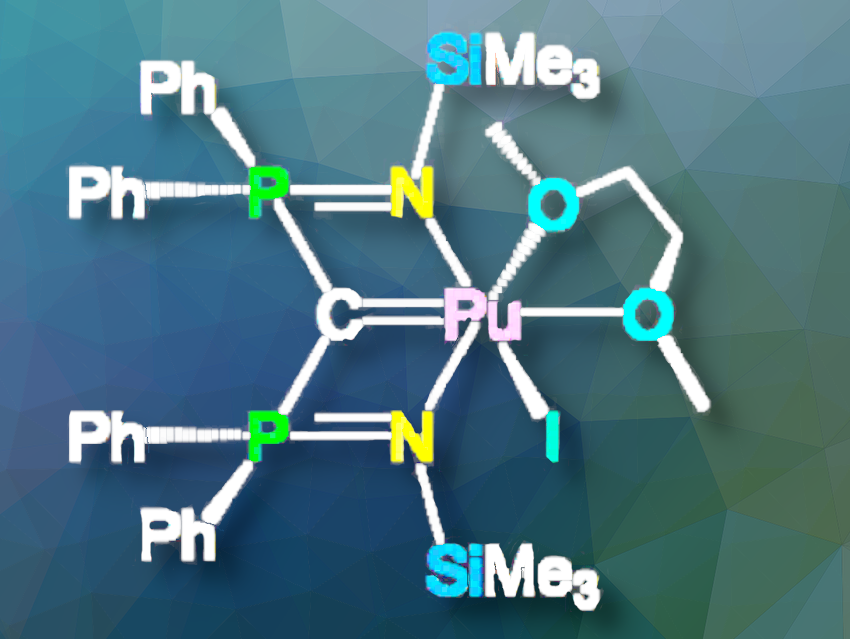Although organoplutonium chemistry began in 1965, the plutonium-carbon bonds found are rare and mainly involve π-bonded carbocycles and σ-bonded isonitriles or hydrocarbons. Plutonium carbenes such as alkylidenes and N-heterocyclic carbenes (NHC) are still unknown.
Jesse Murillo, Andrew J. Gaunt, Los Alamos National Laboratory, NM, USA, Stephen T. Liddle, The University of Manchester, UK, and colleagues have synthesized and characterized the diphosphoniomethanide-plutonium complex [Pu(BIPMTMSH)(I)(μ-I)]2 (1Pu, BIPMTMSH = (Me3SiNPPh2)2CH) and the diphosphonioalkylidene-plutonium complexes [Pu(BIPMTMS)(I)(DME)] (2Pu, BIPMTMS = (Me3SiNPPh2)2C; pictured) and [Pu(BIPMTMS)(I)(IMe4)2] (3Pu, IMe4 = C(NMeCMe)2). By this the team reveals the existence of non-actinyl transneptunium multiple bonds and transneptunium NHC complexes, including the first Pu═C bond.
The Pu═C double and Pu–C dative bonds, alongside new (praseodymium and samarium) and previously reported (uranium, neptunium, and cerium) diphosphonioalkyldiene complexes, facilitate comparisons between lanthanide–actinide and actinide–actinide interactions. The orbital energy matching and spatial overlap terms increase from uranium to neptunium, but the spatial overlap decreases when moving to plutonium. Neptunium shows the highest covalency among the actinides in this series, although plutonium complexes still show significant covalency.
The researchers confirmed Pu═C double bonds in plutonium-diphosphonioalkylidene complexes (compounds 2Pu and 3Pu). Compound 2Pu undergoes metallo-Wittig bond metathesis, representing the highest atomic number element engaged in this reaction. Reactivity differences observed with 2Ce and 2Pr suggest varying covalency in trivalent actinide– and lanthanide–carbon double bonds, influencing reaction outcomes.
These findings shed light on the f- and d-orbital contributions to M═C double bonds, providing insights into their covalency. The recent identification of isolable Np═O, Np═C, and now Pu═C bonds, coupled with modern analytical techniques, sets the stage for further exploration of transuranium metal-ligand multiple bond chemistry, enriching our understanding of actinide coordination and organometallic chemistry, the researchers say.
- Carbene Complexes of Plutonium: Structure, Bonding, and Divergent Reactivity to Lanthanide Analogs,
Jesse Murillo, John A. Seed, Ashley J. Wooles, Meagan S. Oakley, Conrad A. P. Goodwin, Matthew Gregson, David Dan, Nicholas F. Chilton, Andrew J. Gaunt, Stosh A. Kozimor, Stephen T. Liddle, Brian L. Scott,
J. Am. Chem. Soc. 2024.
https://doi.org/10.1021/jacs.3c12719




